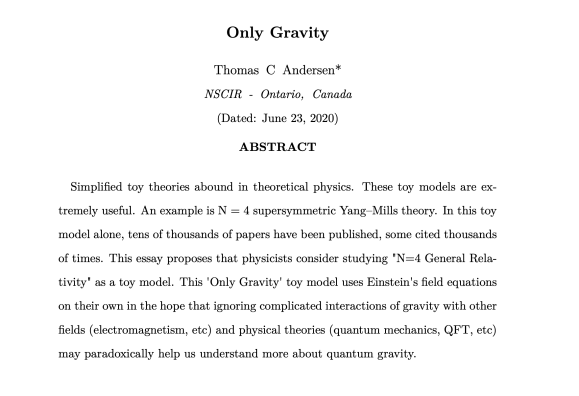Abstract
An electron model is presented where charge, electromagnetic and quantum effects are generated from pilot wave phenomena. The pilot waves are constructed from nothing more than gravitational effects. First the general model of the electron is proposed. Then the physical consequences are laid out, showing that this model can generate large electron – electron forces, which are then identified with the Coulomb force. Further, quantum mechanical effects are shown to emerge from this model.
Electron model:
An electron is modelled as a small region of space which has a varying mass. The origin of this varying mass will not be discussed here. The mass of the electron is given as
me(t) = me*((1 – f) + f*sin(vt))
where v is some frequency, and f is the proportion of mass that is varying, so f is from 0 –> 1
This varying mass will give rise to very large changes in gravitational potential – essentially the time derivative of the mass will be a potential that has a slope proportional to the frequency. Assume that this frequency is very high, and you can see potential for some huge effects to come into play, as compared with the tiny gravitational field of a normal mass the size of an electron.
Throughout this paper only classical physics will be used, and on top of that, the only field used will be that of gravity (GR).
I said that the mechanism for this time – varying mass will not be discussed, but here are two possibilities. One possibility is that electrons are some sort of wormhole, with some portion of their mass disappearing into and out of this wormhole, like some mass bouncing between two open throats. The other more simple way this could happen is if the electron was simply losing mass off to infinity – and getting it back – in a periodic fashion.
Coulomb Attraction
So how would two of these time varying mass electrons interact?
I will use the 2014 paper “Why bouncing droplets are a pretty good model of quantum mechanics“ as a starting point.
Please open up that paper and have a look:
In section 4.3 – 4.4, the authors use analogy of two vacuum cleaners(!) to come up with a mechanism for an “inverse square force of attraction between the nozzles”.
Where ρ is the density of air and Q is the volume of air flow at each nozzle. I will use this train of thought to come up with a similar inverse square relation for my electron model.
In the equation above, ρ*Q gives the mass intake of one nozzle. In my model ρ*Q is thus the same as time rate of change of the mass of the electron, which averages out to f*me*ν, where
f = fraction of electron mass that is varying (f = 1 – me(min)/me)),
me == rest mass of electron,
and
ν = frequncy (greek nu).
So we have f*me*ν == ρQ, substituting into (8) from Brady and Anderson, we get
dp/dt = f*me*ν/(4πr^2)*Q
Where Q is still some volume flow, in m^3/sec. What, though is the volume flow for an electron – its not sucking up the surrounding air! One possibility is to model Q for my electron model as a spherical surface at some ‘electron radius’, with a speed of light as the velocity. So we have Q = 4πre^2*c and we get the force equation:
dp/dt = f*me*ν*(4πre^2*c)/(4πr^2)
This is the force on an electron nearby another electron at distance r in the model.
This should equal the Coulomb force law: (ke is the coulomb constant)
f*me*ν*(re^2*c)/(r^2) = ke*q*q/r^2
f*me*ν*(re^2*c) = ke*q*q
Now the fraction f, the frequency ν and the re are all unknowns. But lets use the classical electron radius for re, and a fraction f equal to the fine structure constant. Then we get solving numerically for ν the frequency… which is about 1000 times the Compton frequency. (So close to it in some ways)
There are of course other options, as the effective radius of this electron is not known and also the mass fraction is unknown. So this result is more for scale’s sake than anything. Still I will use these numbers for the rest of this paper.
Also interesting is to derive the value of the coulomb force between electrons – simply calculate (leave f alone for now),
f*me*ν*(re^2*c)
This gets to about a factor of 1000 or so away from the correct answer for ke*q*q. But not bad considering that I present no reason why to choose the Compton values for radius and frequency, other than a first jab in the dark.
In section 4.5 – 4.10 the authors show how these pulsating bubbles follow Maxwell’s equations to a good approximation. In the model of the electron presented here, that approximation will be orders of magnitude better across a very large parameter space, as the GR field is much better behaved than bubbles in water, to put it mildly.
Its also easy to see that the resulting model is fully compatible with relativity and GR. Its after all made entirely out of gravity.
Quantum Mechanical Behaviour
The electrons modelled here, which only contain a varying mass, can produce electrical effects that exactly match that of the electric field. As the Brady and Anderson paper continues in part 5, so will we here.
In actual fact, since these electrons have been modelled using the same sort of pilot wave phenomena as Brady and Anderson use, there is not much further to do. QM behaviour erupts from these electron models if you follow sections 5, 6 and 7.
Pilot wave behaviour is outlined in the Brady and Anderson paper.
Conclusion
Electrons made with this model exhibit all the expected forces of electromagnetism, all without introducing electric fields at all. Electrical behaviour is then seen as a phenomena of Gravity, rather than its own field.
These electrons also behave according to the laws of QM, all by generating QM effects using pilot wave mechanics.
From the Brady and Anderson conclusion:
“These results explain why droplets undergo single-slit and double-slit diffraction, tunnelling, Anderson localisation, and other behaviour normally associated with quantum mechanical systems. We make testable predictions for the behaviour of droplets near boundary intrusions, and for an analogue of polarised light.”
This I believe shows a possible way to unify Electro Magnetism, General Relativity, and Quantum Mechanics.
Appendix
There would be much work to do to turn this into a proper theory, with some things needed:
1) What happens with multiple electrons in the same region? A: I think that the linearity of GR in this range assures that the results are the same as EM. It would show a path to finding the limits of EM in areas of high energy, etc.
2) How do protons/quarks work? A: It would seem that quarks might be entities with more complicated ways of breathing mass in and out. This is something that is apparent from their larger actual size, which approaches the maximum size allowed to take part in the geometrical pilot wave, which may run at the compton frequency.
3) Why is charge quantized? A: To me, it seems that the answer to this may be that electrons have quantized charge and protons/quarks are using feedback to keep to the same charge. What about electrons, why are they all the same? I think that’s a puzzle for another day, but perhaps a wormhole model of the electron could be made where the frequency and magnitude of the varying mass would be set from GR considerations.
I don’t expect this model to be instantly accurate, or to answer all questions right away, but the draw to unify EM, QM and Gravity is strong. Any leads should be followed up.
See also
Oza, Harris, Rosales & Bush (2014), Pilot-wave dynamics in a rotating frame MIT site: John W.M. Bush Is quantum mechanics just a special case of classical mechanics? Monopole GR waves Other posts on this site as well..–Tom Andersen
May 17, 2014






 Andersen, T. C. on ORCID
Andersen, T. C. on ORCID




Couldn’t there be a varying gravitational potential just by having a spinning non_spherical electron with the center of mass being off-center? Or if it had orbiting particles that were not evenly distributed?